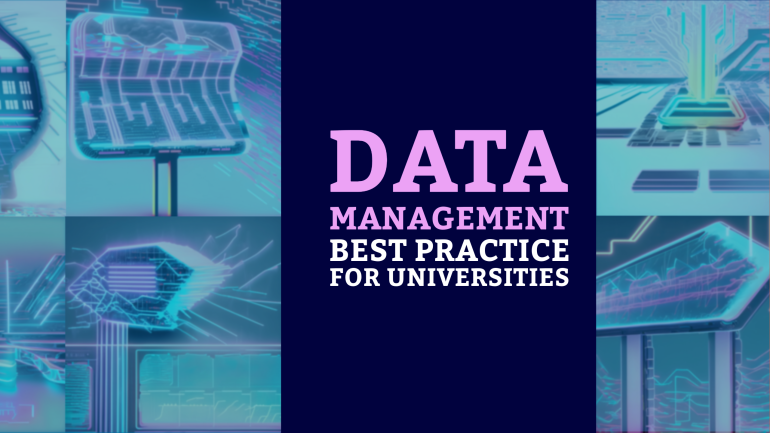This website uses cookies so that we can provide you with the best user experience possible. Cookie information is stored in your browser and performs functions such as recognising you when you return to our website and helping our team to understand which sections of the website you find most interesting and useful.
Table of Contents
TL;DR: Enhancing Academic Excellence through Strategic Data Management in Universities
- Establish Data Governance Framework: Universities should create a structured data governance framework to ensure data is managed effectively and securely.
- Define Data Management Policies: It is important to establish clear policies outlining how data should be collected, stored, and used within the university.
- Implement Data Security Measures: Universities must prioritize data security by implementing encryption, access controls, and regular data backups to protect sensitive information.
- Train Staff on Data Management: Providing training and resources to staff members about data management best practices can help prevent data breaches and ensure compliance with regulations.
- Regularly Monitor and Audit Data Practices: Conducting regular audits and monitoring data practices can help identify any vulnerabilities or areas for improvement in the data management process.
Management of data in universities is a critical task that requires careful planning and execution. With the ever-increasing volume and importance of data in academic institutions, implementing robust data management practices is vital to ensure security, efficiency, and compliance. Proper data management not only safeguards sensitive information but also enhances decision-making processes and enables universities to leverage their data effectively.
The Data Lifecycle in Universities
Data Creation and Collection
Lifecycle of data in universities begins with data creation and collection. This phase involves researchers, faculty members, and students generating new data through experiments, surveys, observations, and other academic activities. It is crucial for universities to establish clear guidelines and protocols for data collection to ensure accuracy, completeness, and consistency.
Data Storage and Preservation
Data storage and preservation are fundamental aspects of the data lifecycle in universities. Proper storage solutions and preservation techniques are vital to maintain the integrity, security, and accessibility of data. Universities must invest in robust data management systems, backup procedures, and disaster recovery plans to safeguard valuable research data.
Universities should implement policies regarding data retention periods, archival processes, and metadata documentation to facilitate the long-term preservation of research data. Additionally, regular data audits and monitoring can help ensure compliance with data management best practices and regulatory requirements.
Data Use and Sharing
Sharing data is an integral part of the data lifecycle in universities, enabling collaboration, transparency, and reproducibility in research. Universities should promote a culture of data sharing while also addressing concerns related to data ownership, intellectual property rights, and data confidentiality.
It is vital for universities to establish data sharing agreements, data access protocols, and data sharing platforms to facilitate the responsible and ethical sharing of research data. By promoting data sharing practices, universities can enhance the impact and relevance of their research outcomes while upholding data privacy and security standards.
Data Archiving and Destruction
Data archiving and destruction are critical components of the data lifecycle in universities. Archiving data ensures the long-term preservation and accessibility of valuable research assets, while proper data destruction practices help mitigate data security risks and regulatory compliance issues.
A comprehensive data retention policy that defines criteria for data archiving, retention periods, and secure data disposal is vital for universities to effectively manage their data lifecycle. By following best practices for data archiving and destruction, universities can optimize storage resources, reduce legal liabilities, and protect sensitive information from unauthorized access.
Developing a Data Management Strategy
Once again, developing a data management strategy is crucial for universities to effectively handle their vast amount of data. This strategy serves as a roadmap that guides the institution in organizing, storing, and utilizing data to support various academic and administrative functions.
Establishing a Data Governance Framework
An vital component of developing a data management strategy is establishing a data governance framework. This framework outlines the policies, procedures, and decision-making processes that ensure data is managed consistently, securely, and in compliance with regulations. By defining roles and responsibilities within the governance structure, universities can effectively oversee data management processes and mitigate risks associated with data misuse or mishandling.
Setting Data Management Roles and Responsibilities
Framework for setting data management roles and responsibilities is crucial to ensure accountability and transparency in data handling practices. By clearly defining who is responsible for data collection, storage, access control, and quality assurance, universities can prevent data silos, duplication, and inaccuracies. This framework also helps in promoting a data-driven culture within the institution, where data is treated as a valuable asset that requires careful management.
For instance, appointing a Chief Data Officer (CDO) can centralize data management efforts and provide strategic direction for data initiatives. This executive role focuses on overseeing data governance, compliance, and data quality assurance across the university, ensuring that data is handled in a standardized and secure manner.
Identifying and Classifying Data Assets
Management of data assets involves identifying and classifying the types of data collected and stored by the university. By categorizing data based on sensitivity, criticality, and usage, universities can prioritize data protection measures and allocate resources effectively. This process also helps in determining data retention policies and access controls to safeguard sensitive information from unauthorized access.
The classification of data assets into categories such as public, internal, restricted, and confidential enables universities to apply appropriate security measures and data handling protocols for each type. Data classification also facilitates data discovery and enhances data visibility, leading to better-informed decision-making processes across the institution.
Data Policy Development
Data policy development is a critical aspect of a robust data management strategy. Data policies serve as guidelines that govern how data is collected, stored, shared, and used within the university ecosystem. These policies outline data handling procedures, data access protocols, data retention requirements, and data breach response mechanisms to ensure compliance with regulatory frameworks and protect sensitive information.
Data policies also promote a culture of data stewardship and responsibility among staff, faculty, and students, emphasizing the importance of ethical and secure data practices in academic and administrative activities. By documenting data policies and communicating them effectively across the university community, institutions can establish a strong foundation for data governance and mitigate potential data risks effectively.
Data Quality Assurance
Implementing Data Standards
Quality data management begins with implementing data standards. Establishing clear and consistent guidelines for how data is collected, stored, and used is important for ensuring data integrity. Data standards help to improve data quality by reducing errors, inconsistencies, and redundancies in the data.
Data Accuracy and Validation Processes
With data accuracy and validation processes in place, universities can ensure that the data they collect is reliable and trustworthy. These processes involve regularly monitoring and verifying the accuracy of data through various validation techniques such as data profiling, data cleansing, and data matching. By identifying and correcting errors early on, universities can maintain high data quality and make informed decisions based on trustworthy data.
Standards: Data accuracy and validation processes help to identify and rectify errors in the data, ensuring that decision-making is based on accurate information. By implementing data accuracy and validation processes, universities can have confidence in the quality of the data they use for reporting, analysis, and decision-making.
Continuous Data Quality Improvement Practices
Data quality is an ongoing process that requires continuous data quality improvement practices. Universities should regularly assess the effectiveness of their data management strategies, identify areas for improvement, and implement changes to enhance data quality. By continuously monitoring and improving data quality, universities can ensure that their data remains accurate, reliable, and up-to-date.
Implementing: Continuous data quality improvement practices involve establishing feedback mechanisms, conducting regular audits, and providing training to staff members on best practices for data management. By prioritizing continuous data quality improvement, universities can effectively adapt to changing data needs and maintain high standards of data quality in the long term.
Data Security and Compliance
Understanding Regulatory Compliance Requirements
Requirements: Universities are required to adhere to a myriad of regulatory compliance requirements to ensure the security and privacy of their data. Regulations such as HIPAA, FERPA, GDPR, and PCI DSS dictate how universities must handle, store, and protect sensitive information. Failure to comply with these regulations can result in severe penalties, including fines and reputational damage.
Implementing Data Protection Measures
Requirements: Implementing data protection measures is crucial for universities to safeguard against data breaches and cyber threats. Encryption, access controls, regular security updates, and employee training on data security best practices are imperative components of a robust data protection strategy.
Security: Data protection measures go beyond just protecting data from external threats. It also involves ensuring that data is only accessible to authorized personnel and is encrypted both in transit and at rest to prevent unauthorized access.
Managing Data Breaches and Security Incidents
Protection: In the event of a data breach or security incident, universities must have a comprehensive incident response plan in place. This plan should outline the steps to take to contain the breach, mitigate its impact, notify affected parties, and comply with regulatory requirements.
A: Timely response and communication are critical in managing data breaches to minimize the potential damage to the university’s reputation and ensure compliance with data protection regulations.
Conducting Regular Security Audits and Assessments
Assessments: Regular security audits and assessments are imperative for universities to proactively identify and address vulnerabilities in their data security practices. Conducting penetration testing, vulnerability scans, and security assessments help universities stay ahead of potential threats and ensure ongoing compliance with regulatory requirements.
Managing: Universities should engage third-party security experts to conduct independent audits and assessments to provide unbiased insights into their security posture. These assessments help universities identify weaknesses in their security measures and implement necessary improvements to enhance their overall data protection capabilities.
Data Sharing and Collaboration
Promoting a Culture of Open Data and Transparency
Your university can play a crucial role in promoting a culture of open data and transparency. By making research data openly accessible, you not only foster collaboration among researchers but also contribute to the advancement of knowledge across various disciplines. Encouraging data sharing within the academic community can lead to increased visibility of your institution and establish it as a hub for cutting-edge research.
Data Sharing Agreements and Partnerships
An imperative aspect of data sharing is establishing clear agreements and partnerships with external organizations or researchers. These agreements outline the terms of data sharing, including access permissions, usage rights, and data ownership. Creating robust data sharing agreements ensures that data is handled ethically and in compliance with applicable laws and regulations.
Partnerships with industry partners or other academic institutions can also facilitate data sharing and collaborative research projects. By forging strategic partnerships, universities can leverage each other’s expertise and resources to address complex research challenges and drive innovation in various fields.
Data Repositories and Access Control
On establishing data repositories, it is crucial to implement appropriate access controls to safeguard sensitive information and protect intellectual property. Data repositories provide a centralized platform for storing and sharing research data, enabling researchers to easily access and collaborate on datasets while ensuring data security and integrity.
For instance, universities can use data management platforms with customizable access controls to manage permissions and track data usage. By implementing strict access controls, universities can prevent unauthorized access to sensitive data and mitigate the risk of data breaches.
Ethical Considerations in Data Sharing
Access to data comes with ethical responsibilities that universities must address. It’s crucial to consider the privacy and confidentiality of research participants, ensure informed consent is obtained for data sharing, and anonymize sensitive information to protect individuals’ identities. Adhering to ethical guidelines and standards when sharing data is paramount to maintaining trust and integrity in research practices.
Understanding the ethical implications of data sharing is imperative for universities to uphold ethical standards and safeguard the rights of research participants. By prioritizing ethical considerations in data sharing practices, universities can build a reputation for ethical research conduct and foster a culture of trust and collaboration among researchers.
Data Storage Solutions and Infrastructure
Evaluating On-Premises vs. Cloud Storage Options
Options for data storage solutions in universities often involve a choice between on-premises and cloud storage. On-premises storage refers to data centers maintained within the university premises, providing full control and customization but demanding significant hardware and maintenance costs. In contrast, cloud storage offers scalability, accessibility, and potential cost savings but may raise concerns about data security and compliance.
Data Backup and Recovery Strategies
Evaluating data backup and recovery strategies is vital for universities to ensure the safety and availability of their valuable data. Backup solutions should include regular automated backups, off-site storage for disaster recovery, and testing of recovery processes to guarantee data integrity. Implementing a comprehensive backup strategy reduces the risk of data loss due to hardware failures, cyber-attacks, or human error.
Solutions for data backup and recovery often involve a combination of on-premises and cloud solutions to provide redundancy and flexibility. Backup schedules should be tailored to the university’s data generation rate and criticality to ensure efficient and reliable data protection.
Sustainable Data Infrastructure for Long-Term Accessibility
Options for sustainable data infrastructure in universities involve establishing effective long-term data management practices to ensure data accessibility and usability over time. This includes identifying metadata standards, data classification, and preservation strategies to support data sharing, collaboration, and compliance with funding agency requirements.
A proactive approach to data infrastructure sustainability involves regular assessment of storage systems, data formats, and migration processes to adapt to evolving technology and information needs. Universities can benefit from investing in scalable storage solutions and data management tools that support long-term data preservation and access.
Managing Costs and Resource Allocation
Evaluating costs and resource allocation strategies is crucial for universities to optimize data storage infrastructure efficiency without compromising data security or availability. This involves conducting regular audits of storage utilization, implementing data lifecycle management policies, and exploring cost-effective storage options such as tiered storage or data deduplication.
Backup strategies should align with budget constraints and data criticality, prioritizing resources for vital data and leveraging cost-effective solutions for non-vital data. By strategically managing costs and resources, universities can achieve a balance between data accessibility, security, and affordability in their data storage infrastructure.
Training and Support for Data Management
Developing Comprehensive Training Programs
All universities should have comprehensive training programs in place to educate staff and students on the importance of data management best practices. These programs should cover a range of topics, including data security, data privacy, data storage, and data sharing. By providing training on these vital topics, universities can ensure that all individuals handling data are well-informed and equipped to protect sensitive information.
Providing Support Resources and Help Desks
Universities must establish support resources and help desks to assist individuals with any data management issues or questions they may have. These resources should be easily accessible and staffed with knowledgeable experts who can provide guidance on best practices and troubleshooting assistance. By offering robust support services, universities can empower their staff and students to handle data effectively and securely.
Support resources such as online guides, FAQs, and live chat support can be particularly beneficial for individuals seeking quick assistance with data management tasks. Having a dedicated help desk can also streamline the process of resolving more complex issues, ensuring that data-related problems are addressed promptly and efficiently.
Encouraging Ongoing Learning and Professional Development
To encourage ongoing learning and professional development in data management, universities should provide opportunities for staff and students to attend workshops, webinars, and training sessions. By investing in continued education, individuals can stay up-to-date on the latest trends and technologies in data management, enabling them to enhance their skills and knowledge in this critical area.
Help individuals set personal development goals related to data management and offer incentives for achieving these goals, such as certifications or recognitions. By fostering a culture of continuous learning, universities can cultivate a workforce that is well-equipped to handle the evolving demands of data management.
Building a Community of Data Management Practice
To promote collaboration and knowledge sharing, universities should focus on building a community of data management practice. This can involve creating forums, discussion groups, or online platforms where staff and students can exchange ideas, ask questions, and share best practices related to data management. By fostering a sense of community, universities can create a supportive environment where individuals can learn from each other and work together to improve data management processes.
Training sessions and workshops can also be organized within this community to facilitate skill-building and networking opportunities. By bringing individuals with varying levels of expertise together, universities can create a rich learning environment that benefits all participants and contributes to a culture of data management excellence.
To wrap up
Considering all points, data management best practices are crucial for universities to ensure efficiency, compliance, and data security. By implementing proper data governance policies, utilizing advanced data management tools, providing training for staff members, and fostering a culture of data stewardship, universities can effectively handle the vast amounts of data they collect and utilize it to drive decision-making and improve operations.
Overall, prioritizing data management best practices not only helps universities maintain the integrity and quality of their data but also enables them to leverage data as a strategic asset. With the ever-increasing volume and complexity of data in today’s digital age, adopting a proactive approach to data management is necessary for universities to stay at the forefront of innovation and excellence in higher education.
FAQ
Q: What are some best practices for data management in universities?
A: Implementing regular data backups, setting access controls, conducting regular security audits, providing training to staff, and adhering to data protection regulations are some key best practices for data management in universities.
Q: How important is data management in universities?
A: Data management is crucial for universities as it helps ensure data security, accuracy, and accessibility, which are vital for decision-making, research, and compliance with regulations.
Q: What are the risks of poor data management in universities?
A: Poor data management in universities can lead to data breaches, loss of sensitive information, non-compliance with regulations, damaged reputation, and hindered academic and research progress.
Q: How can universities ensure data compliance with regulations?
A: Universities can ensure data compliance by staying informed about relevant regulations, implementing data protection policies, conducting regular audits, providing training to staff, and utilizing secure data management tools.
Q: How can universities improve data management practices?
A: Universities can improve data management practices by investing in secure data storage solutions, establishing clear data governance policies, implementing data encryption techniques, and fostering a culture of data security and accountability among staff and students.





